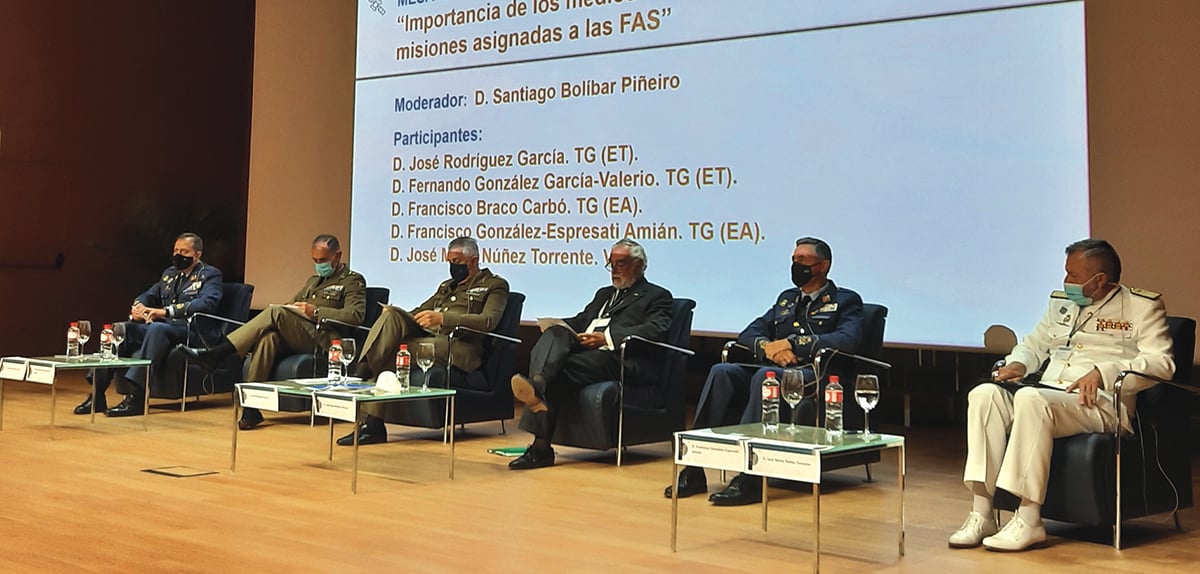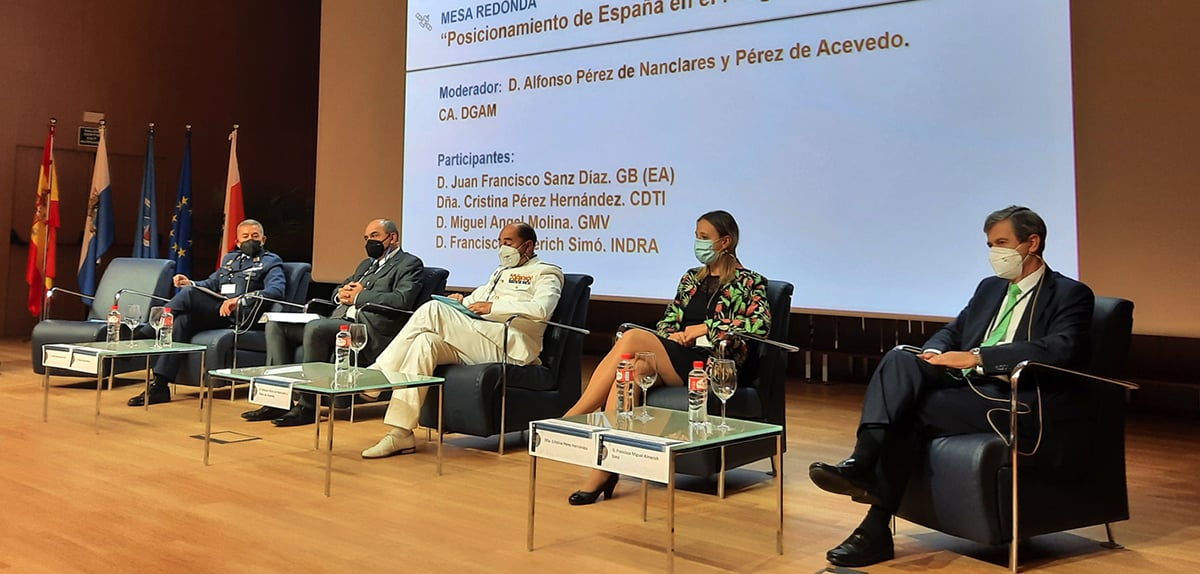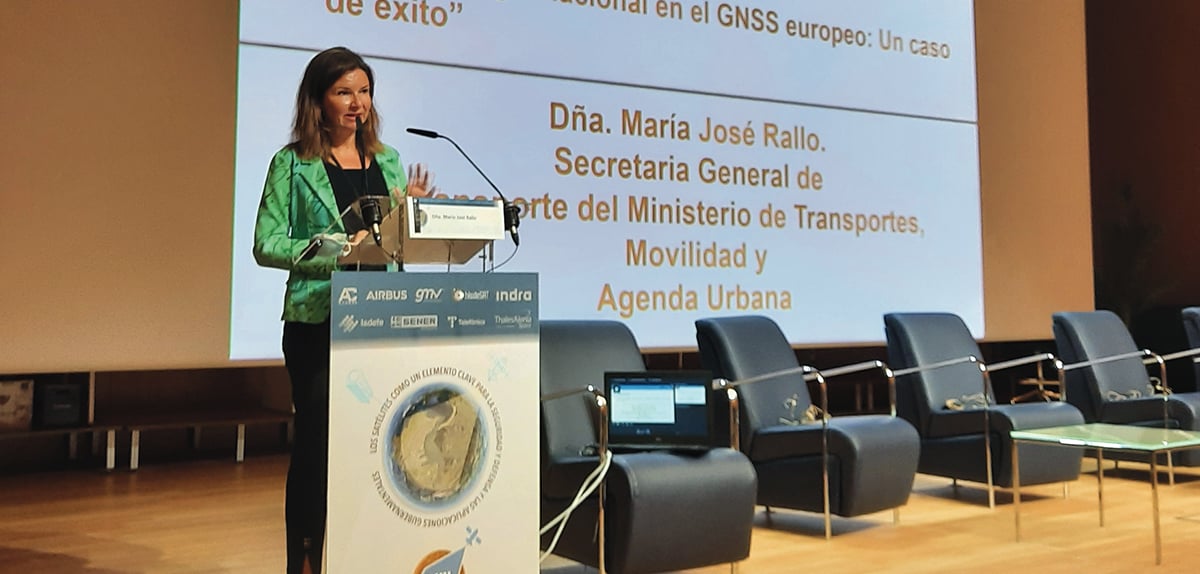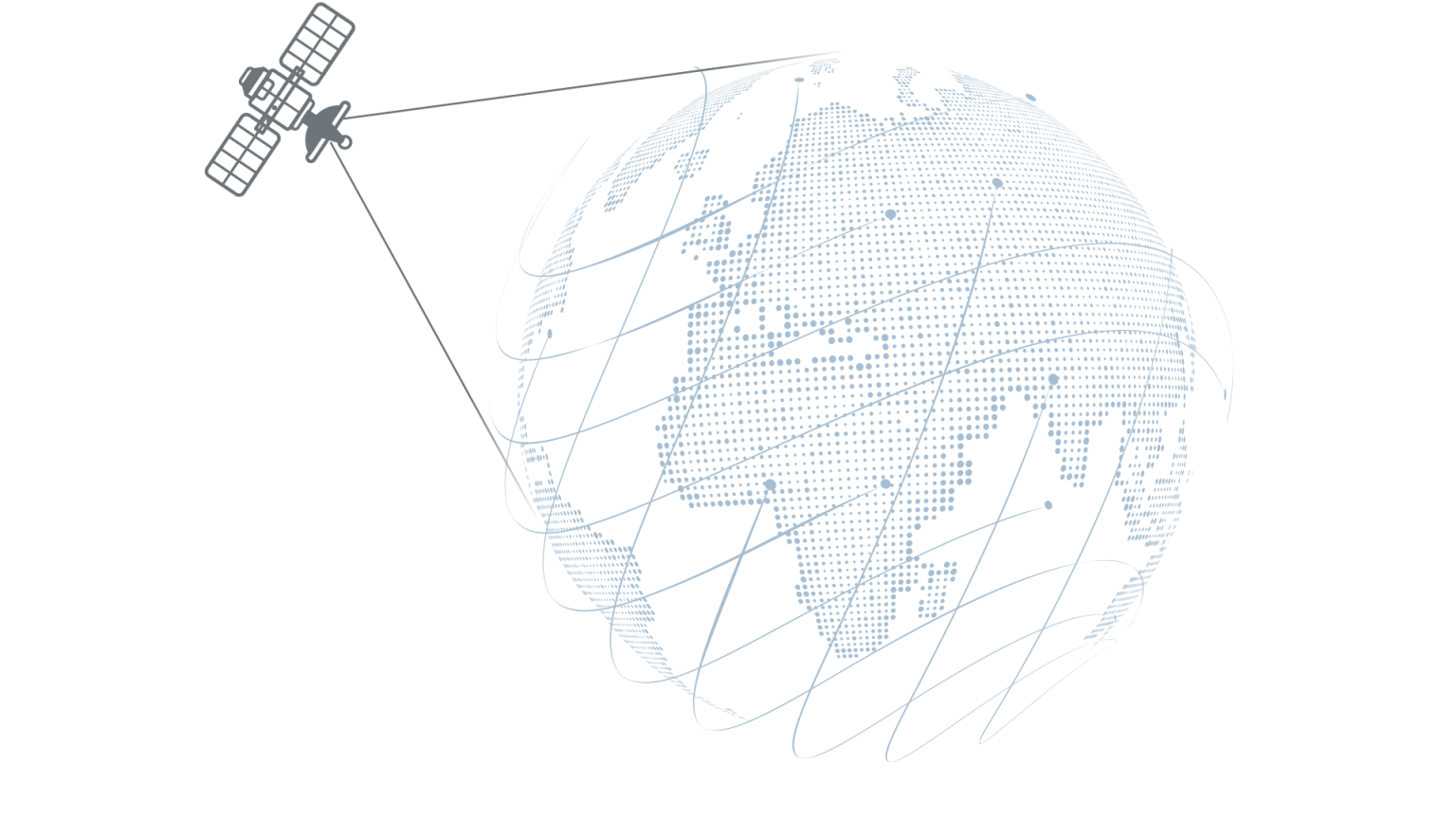The annual AMETIC Seminar “Satellites as a key element for the security and defense of government applications” reached its 13th edition, after its interruption in 2020 due to the pandemic. A much expected gathering with a tight schedule that addressed a number of fundamental issues for the Spanish Space Industry, the Armed Forces and the Administration in relation to space, both as a country and within the European landscape.
In a special opening speech by Admiral General Teodoro Esteban López Calderón, Defense Chief of Staff (JEMAD), he stressed that “space assets are of strategic importance in the fields of security and defense, and are conditioned by technological innovation.”
He also highlighted the importance of satellite capabilities for command, control & communication operations; Earth observation for geospatial intelligence, navigation systems, meteosat data and targeting..
Space is increasingly cluttered by space junk, We need to move forward with a civilian and military space management system" GD. Juan Francisco Sanz
In addition, he analyzed the current and future projects that the Ministry of Defense is focusing on and which are vital to its military activities, which include: the bandwidth increase via the UHF of the new SPAINSAT NG satellites, the acquisition of a proprietary optical satellite (Helios II is nearing the end of its service life), the acquisition of a new radar system to replace the PAZ satellite at the end of its service life, and the importance of the services offered by Galileo.
The Admiral remembered the milestone reached with the creation of the Centro de Operaciones de Vigilancia Espacial (Space Surveillance Operations Center, COVE) in 2019, with the mission of surveilling and knowing the situation of space and providing support services to all other operations carried out by the Armed Forces, which will reach its top operational capabilities by 2023.
His speech can be summarized as achievements and projects, where he insisted on the “importance of outer space in all military operations.”
The importance of satellites in operations and missions assigned to the armed forces
The first roundtable related to the title above included a number of experts of the three branches of the armed forces. During his talk, the Chief of the Fuerza Terrestre (Land Forces), Lieutenant General José Rodríguez García, highlighted that “units must be prepared to perform missions under the best conditions, and their needs include satellite capabilities that increase redundancy in high intensity combat, humanitarian efforts and the orientation of antennas for a higher mobility.”
The Chairman of the Joint Chiefs of Staff (JEMACON), Lieutenant General Fernando Gonzalez, firmly stated that “in all military operations, it is essential to control space, and for this reason it must be secured.” He gave examples of the important role of satellites in scenarios such as Afghanistan and the Ceuta border, in addition to stressing the challenges of the militarization of space, calling on the audience to reflect on the level of national ambition in this regard.
For his part, the Commander of the Mando de Operaciones (Operations Command), Lieutenant General Francisco Braco Carbó, pointed to the need for a Law that regulates space. And Lieutenant General Francisco González-Espresati, Chief of the Mando Aéreo de Combate (Aerial Combat Command) highlighted “the importance of space superiority in a country, with special focus on capabilities that guarantee a decisive control over the operations.”
Vice Admiral José María Núñez Torrente, Commander of the Cuartel General Marítimo de Alta Disponibilidad (High Availability Maritime Headquarters) gave a number of important messages, highlighting the fact that “there are no military operations without space, and space is cross cutting, it is necessary to guarantee space superiority.” As head of the ATALANTA operation against piracy, he highlighted that “the naval force will continue relying more and more on satellites and UAVs.” In the field of communications, “the SPAIN-SAT NG Program will provide us with new capabilities and we are already working on other virtual twin concepts with NAVANTIA, the creation of virtual remote platforms and artificial intelligence.” In closing, he brought forward “the challenge of guaranteeing access and interoperability with allied navies.”

Next, the “New challenges of the Spanish Space and Defense Industry: Next Generation Funds” conference was given by the president of TEDAE, Ricardo Martí Fluxá, who insisted on “acknowledging the leadership of our country as a European leader in Space and Defense and taking advantage of the European recovery funds.” He also stressed the importance of increasing cybersecurity and proposing new, more competitive business models.”
The SST European Program
This important subject was the focus of another roundtable moderated by Alfonso Pérez de Nanclares, Commander of the Satellite and Cyberdefense Command of the General Sub directorate of Programs of the DGAM. The Chief of the Aerospace Surveillance and Control System of the Aerial Combat Command, Division General Juan Sanz Díaz, highlighted “the current situation of space, which is increasingly cluttered by space junk, and the need to move forward with a civilian and military space management system.”
The ground and operations segment of GMV also gave their opinion through Miguel Angel Molina, Strategy and Business Development Director, expressing the will to “turn it into a leading program of the European Union.”

The space industry and the national challenges
With an optimistic outlook on the current situation of the industry, and summarizing the Strategic Projects for Recovery and Transformation of the Economy (PERTE), Raul Blanco, Secretary General of Industry and SMEs, part of the Ministry of Industry, Commerce and Tourism, claimed that they are “working on the Statements of Interest of several space programs focused on different fields which include Earth Observation Satellite capabilities, quantum communications, etc.” And he closed by saying that “all projects that are set in motion today will allow us to grow during the next twenty years.”
The national strategy in Europe’s GNSS
The Administration also gave its view on the GALILEO program, the European satellite navigation and positioning system of the EU managed by ESA and operated by the European Union Agency for the Space Program (EUSPA). María José Rallo, Secretary General of Transportation of the Ministry of Transport, Mobility and Urban Agenda, stated that “Galileo has demonstrated that Spain is highly competitive, especially in the next generation satellite control and construction segment.”
Galileo has demonstrated that spain is highly competitive, especially in the next generation satellite control and construction segment” María José Rallo. Secretary General of Transportation of the Ministry of Transport, Mobility and Urban Agenda.
Galileo’s services include the Public Regulated Service (PRS), which was born out of an analysis of possible threats to the Galileo system and the identification of scenarios where jamming its signal could harm national security or economic activities in important geographic regions. According to Rallo, “taking part of the PRS modules has essential economic benefits for us.” He concluded by raising awareness about the potential challenge that is brewing in relation to commercial space transportation.

Earth Observation
Three years after the PAZ radar satellite was put in orbit, its performance and operability was assessed in a positive light, while also discussing other new requirements that have emerged during that time that must be taken into account in a future radar system set to replace the current one at the end of its service life.
The Chief of the Center for Aerospace Observation Systems (CESAEROB), Colonel Francisco Javier Hidalgo Rivero, highlighted “how important it is for the national defense system to have the independence and discretion offered by PAZ, which has made us addicted to the radar spectrum, thanks, in part, to its great performance.”
With sights set on the mid term future, he noted the new technological needs they have been faced with: “a demand for more spatial resolutions and a higher radiometric performance, in addition to increasing the accessibility to objectives and the real time obtainment of images and the memory aboard satellites.” He closed his enthusiastic talk by insisting on going one step further with PAZ: “we want a system that is faster, more robust and reliable.”
His talk was followed by the Hisdesat Payload Director, Basilio Garrido, who informed the audience that during these three years in operation, the PAZ satellite has provided the Ministry of Defense with over 35,000 images. He also highlighted a few milestones reached since last year, such as: two new modes of operation (making a total of five now) without service interruption, the adaptation of the operational space and ground segments and a consolidated service working at peak performance. He stressed the need to increase its speed to less than 60 seconds per shot, to have a revisit capacity of less than 24 hours, and to achieve a higher resolution and bandwidth, despite these being conflicting requirements. He insisted that “there is no system like PAZ operating at the time in the entire globe.”
The PAZ satellite contractor, Airbus D&S, through the words of Alfonso Martínez, Director of Systems Engineering, revealed that “the experience acquired through the operation of PAZ is invaluable and we must apply it to a future PAZ 2.” In regard to the idea of developing a new system, the company proposes an active antenna, multiplying the image resolution by four, adding a 12 TB memory and the NEO platform. He highlighted that “over 65% of a new radar satellite can be developed by the Spanish space industry.”
Diego Rodríguez, director of the Space Department of SENER Aeroespacial, pointed to “the need to count with driving programs that get started as soon as possible.”
EDIDP y EDF
The conference of the Assistant Director General of Planning, Technology and Innovation (DGAM), Division General José Luis Murga, entitled “a window into industrial growth,” started with him pointing out “the need to guarantee the access to space, give an increasing level of attention to New Space initiatives and foster a coherence in the planning of capabilities and resources of the EU and the Ministry of Defense.”
He highlighted the importance of the programs that are being undertaken within the framework of the European Defence Industry Development Program (EDIDP), such as: GEODE (GALILEO for EU Defense), OPTISSE (very high resolution optical payload for Smallsat for Defense Applications), PEONEER (Persistent EO for actionable intelligence, surveillance and reconnaissance), in addition to another four programs: NEMOS (Navy Earth Map Observation Sat), INTEGRAL(International Gamma Ray Astrophysics Laboratory), SAURON (Scalable Multidimensional Situation Awareness Solution For Protecting European Ports) and ODIN’S Eye (multinational initiative for a missile early warning architecture based in space).
I3D and Space
Within the framework of the Integral Information Infrastructure for the Ministry of Defense (I3D), the Director of the Center for Defense Information and Communication Technology Systems (CESTIC), Division General José María Millán Martínez, stated his satisfaction over the good results yielded by the Personnel Support Systems in Operating Areas Program (SAPZO). This initiative, led by UTE, Telefónica and Hisdesat, takes quality “welfare” services to international land and sea operating regions, allowing Spanish troops deployed off country to have access to multimedia streaming contents (TV series, movies, documentaries, etc.), educational content (languages, training courses, etc.), access to broadband internet and safe telephony services, through their own devices, whether mobiles, tablets or personal computers. This used to be entrusted to local providers, implying a significant vulnerability.
The General also praised the great investment project for 65 million euros within six years for essential capabilities to be provided by the new SPAINSAT NG satellites, with a significant impact on the I3D: “the X capacity will be multiplied by 4, Ka by 35, and we will count with 760MHzx2 on the X band and 648MHzx2 on the Ka band.”
Challenges facing the new (2021-2027) EU MFF
This roundtable raised great concern around the feasibility of managing the European funds and retaining talent in the corporate world.
Manuel Lobeira, general director of ACORDE Technologies, called for “reorienting the technological focuses in the face of the problem of having too many funds to execute programs and little time to do so, on top of the issue of the lack of qualified personnel.” Along this same line, another participant, Sergio Gamo, Telefónica’s Defense and Intelligence Strategic Account Manager, stated the “need to focus funds while retaining talent, choosing projects well, betting on New Space and projecting what was learned in Europe to implement initiatives in Latin America.
To summarize, the roundtable’s moderator, Division General Antonio Planells, assigned to the DIGAM, concluded by highlighting the need to establish a “space leadership, work toward a unique digital market, dual usability and the fostering of opportunities for SMEs.”
Space strategy In the EU
As stated by Pascual Navarro, the Director General for Europe of the Ministry of Foreign Affairs, the ministry’s vision is that “it is necessary to foster an innovative industry, with autonomous access to space, simplify the governance and guarantee the continued leadership in Europe, maximizing the benefits of space.” He also highlighted Europe’s work on space traffic through research activities, the development of capabilities, the standardization, the definition of operational capabilities and safety.
INTA and the challenges of Space
Lleutenant General José María Salom, director general of INTA, reflected, during the final moments of the seminar, about space as a “strategic, horizontal and dual use” element and highlighted the importance of the public sector as a “user, promoter and regulator.”
He stated that “Spain must be in the lead in the New Space group and, for this, it is necessary to establish a convergence strategy by being strong in that field and positioning the industry in the traditional large satellite sector.” And he closed his speech by saying that “space is dual use and the sector must be developed with that duality as the most efficient approach.”
Challenges and Normality
The last roundtable addressed the unavoidable subject that has driven our personal and work agendas this past year, under the title “The defense industrial and space sector in the post Covid era.” Many companies, like Airbus D&S, Hisdesat, TASE, INDRA, and ISDEFE, gave their specific views based on their experiences during this difficult period, where they made special efforts to adapt their personnel, facilities and projects while taking care of the business side, which has continued operating generating positive results.
Pedro Fuster, Assistant Director General of Inspection, Regulation and Industrial Strategy for Defense (DGAM) and moderator of the roundtable, thanked the attendees and the organizers for resuming this annual gathering, which he qualified as a “space summit” that serves as a starting point for the space related work of the Spanish Administration and Industry.
The Director General of Armament and Materiel, Admiral Santiago Ramón, was in charge of closing the Seminar.





